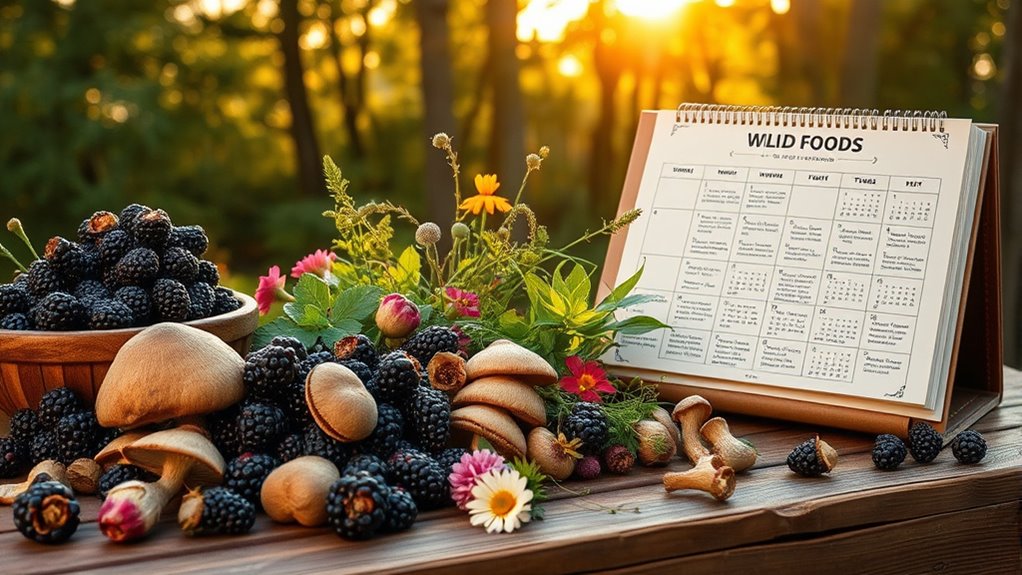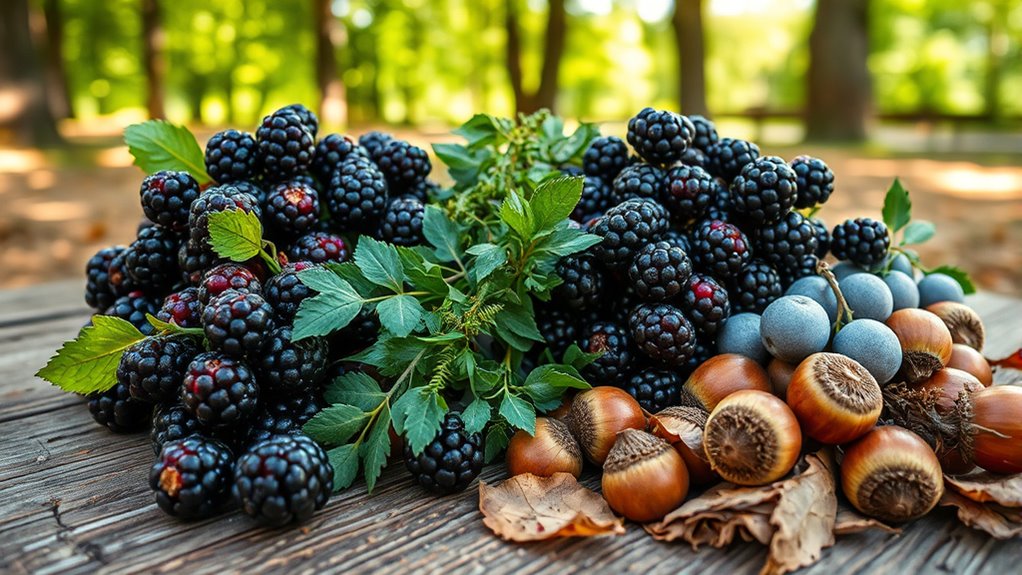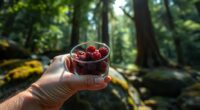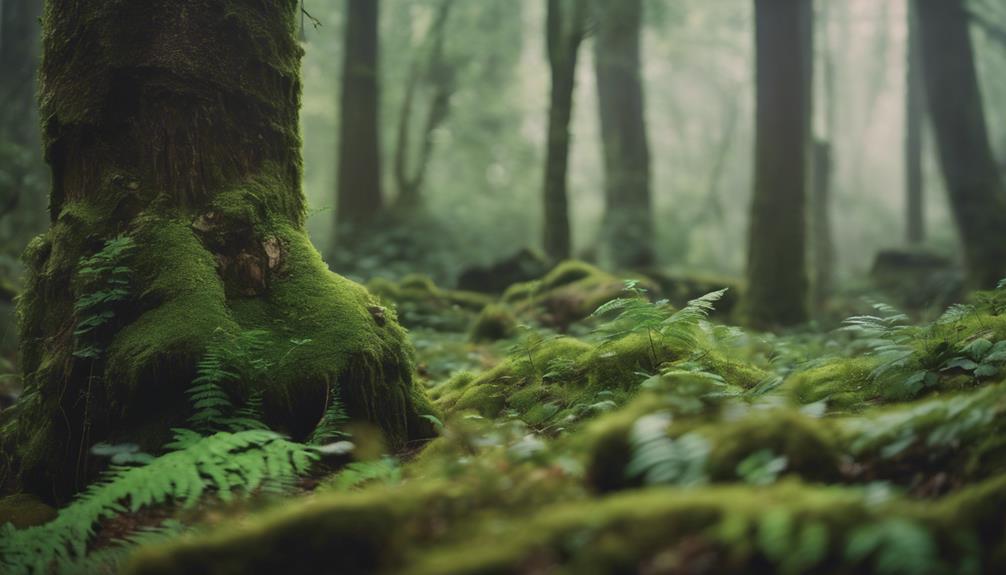To build a 12-month wild harvest calendar, start by observing local plant and mushroom cycles, noting when they appear and peak each season. Use tools like journals or apps to track your findings, considering weather patterns and previous years’ data. Map out key harvest times for berries, greens, and fungi, and modify as needed for variation. Keep sustainability in mind to guarantee future abundance—exploring these steps further will help you create a reliable, year-round foraging plan.
Key Takeaways
- Track local seasonal emergence of wild edibles through consistent observation and note-taking.
- Use historical and multi-year data to identify reliable harvest windows for various species.
- Incorporate weather patterns and environmental cues to refine harvest timing throughout the year.
- Create a detailed, month-by-month calendar highlighting peak foraging periods for plants, fungi, and berries.
- Follow sustainable harvesting practices to ensure long-term availability and ecosystem health.

Have you ever wondered how to stay ahead of the seasons and plan your year effectively? Creating a 12-month calendar of wild harvests near you requires more than just knowing what grows in your area; it demands understanding foraging techniques and seasonal tracking. By mastering these skills, you can anticipate when certain plants, mushrooms, or berries will be ripe for harvest, guaranteeing you gather them at their peak flavor and nutritional value.
Start by learning the foraging techniques specific to your region. This involves familiarizing yourself with local flora and understanding how different plants appear and mature throughout the year. Use field guides, local workshops, or online communities to identify key species and their growth habits. Pay attention to the subtle signs that signal when a plant is ready—such as color changes, fruiting bodies, or leaf development. This knowledge will help you plan your foraging trips more efficiently and confidently. Additionally, understanding seasonal tracking can improve your harvest timing and ensure sustainable practices.
Learn regional foraging techniques and identify key plants for successful seasonal harvesting.
Seasonal tracking is equally vital. Keep a detailed calendar that notes when particular wild edibles tend to emerge or peak in your area. Observe patterns over multiple years to identify consistent timings. For example, certain wild greens might be abundant in early spring, while berries reach their ripeness in mid-summer. Tracking these seasonal shifts allows you to predict the best times to harvest, avoiding the guesswork that often leads to missing out or harvesting too early or late.
Implement practical tools like a journal, a digital app, or even a simple spreadsheet to record your observations. Note weather conditions, plant appearances, and harvest dates. Over time, this record becomes invaluable as it reveals trends and helps you plan your foraging schedule months in advance. Additionally, stay updated with local foraging guidelines and regulations to assure sustainable harvesting—only taking what you need and leaving enough for the plants to regenerate.
Frequently Asked Questions
How Do I Customize the Calendar for My Specific Region?
To customize your calendar for your region, start by researching your area’s regional climate and local flora. Note when specific plants and wild edibles typically harvest, which varies with seasonal changes. Use local foraging guides or talk to experienced foragers to get tailored insights. Adjust your calendar based on these observations, ensuring you harvest at peak times for safety, sustainability, and ideal flavor.
Can I Add Personal Harvest Notes to the Calendar?
Oh, of course, because who wouldn’t want to turn their wild harvests into a legendary saga? You can definitely add personal notes to your calendar—think of it as harvest journaling. Jot down what you gathered, when, and how it went. It’s your own wild adventure, after all. This way, you’ll remember every delicious detail and make future foraging even more epic.
What Tools Are Recommended for Tracking Wild Harvests?
To track your wild harvests effectively, you should consider using tools like GPS mapping to mark exact locations and a Wild Harvest Journal to record details such as date, species, and quantity. These tools help you stay organized and improve future foraging. Combining digital GPS devices with a dedicated journal guarantees you capture precise data and personal notes, making your wild harvesting experience more sustainable and enjoyable.
Is There a Mobile App Version of Gleaner’S Almanac?
Think of your wild harvests as a symphony waiting to be conducted—now, imagine a mobile app as your baton. Currently, there’s no dedicated Gleaner’s Almanac mobile app, but you can use a digital calendar to track seasonal changes and harvests. This way, you stay in tune with nature’s rhythm, turning your phone into a conductor’s wand, guiding you through a year of wild bounty.
How Often Should I Update My Harvest Calendar?
You should update your harvest calendar at least once a season to stay current with seasonal foraging opportunities. Regular updates help you practice sustainable harvesting and adapt to changes in plant availability. Keep track of local conditions, weather, and plant cycles, so you can harvest responsibly and enjoy wild foods at their peak. Updating seasonally guarantees your foraging remains sustainable and aligned with nature’s rhythms.
Conclusion
Now, as you embrace this 12-month journey, you’re planting seeds of connection with nature’s rhythm. With each harvest, you’re carving out moments of discovery—a tapestry woven with the sun’s warmth and the earth’s bounty. Let this calendar be your guiding star, illuminating the hidden treasures around you. Soon, you’ll find yourself dancing in harmony with the seasons, turning every wild harvest into a story written in the language of the land.










